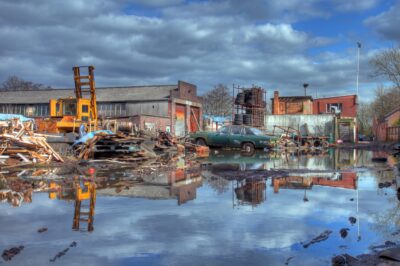Managing Waste might have been on your mind as you cleaned up after a family celebration that welcomed summer with our 2021 Memorial Day Holiday. Of course, we cannot resist hoping you used sustainable containers and tableware for your picnic.
At Consolidated Waste Systems, we have tender hearts for the environment. We hope no wildlife will suffer from your non-biodegradable plasticware, cups, or straws.

1960’s: Water Pollution Hurt Cities, Great and Small. Out Cries for Legislation Saved the Great Lakes.
Everywhere we are seeing improvement in this small but mighty regard for Summer 2021. We’re proud of our country for beginning to re-think plastic use. We are finally emerging from what Consolidated Waste System calls the “Modern Dark Ages of Managing Waste.” Specifically, we refer to the 19th and 20 centuries.
Exploring the Past, Present, and Future of Managing Waste—from Swine to Eternity
In our most recent blogs, Consolidated Systems Waste Systems concentrated on a plastic usage and waste crisis. Please read or review our previous CWM articles on our current plastic crisis. Note how, even in the 21st century, we are just beginning to fight the plastic contamination of our oceans, rivers, land, and food sources.
Our Extended Invitation: Seeing the Truth in Plastic Waste
We interrupted our previous series (“Waste Control: How Far Have We Come?”) to cover the more critical topic of the Plastic Invasion.
In that series of blogs, we showed our readers how MicroPlastics and NanoPlastics are threatening our present life on earth in frightening new ways.
The above issues deal with the present. Now, as we promised, let’s peer into the past. We want to see if we are progressing as we struggle to manage the wasted by-products of civilization. Bring on the swine!
8000 Swine and Other Crimes of Managing Waste in Modern Times
In this week’s blog article, CWS will take you back in time. Thus, we hope, by glimpsing our past efforts at managing waste, we can build a better future. Plus, we can applaud ourselves for our improvement in recent years.
A Time Traveler’s View: The Plight of Pigs in the Past

This Happy 21st Century Swine Smiles Because We Do Not Force Him to Eat Our Trash, Cooked or Raw.
We now transport you to the time when small cities believed in controlling waste by keeping a heard of fine swine at the edge of an open city landfill. Picture smoking debris, clouds of biting flies, and hoards of mosquitoes at the edge of town. Above your head, a couple of skinny buzzards and a hundred fat crows circle the feast.
Don’t step on the rats and watch out for the coyotes that lurk at twilight. The pigs patrol the perimeter until dusk. If you think we are exaggerating, check out this authentic report from a 1949 California landfill:
Workers “dropped and spread-out waste over a large area to allow scavengers easy access. At the end of the day pigs fed “on the spread-out refuse for overnight feeding.”
Later, swineherders shepherded the swine home. Then, the workers pushed the leftovers to the edge of the fill for burning. This process was repeated day in and day out —or at least repeated until swine sickened and died.
Soon, the cities passed ordinances that all garbage had to be cooked before dumping so it would not make the swine sick. Now, these weren’t the only laws necessitated by these early so-called “modern” dumps.
Managing Waste with Early Legislation: Before Swine got Prime Time
Before the popularity of using swine, we had some other interesting waste managing techniques and resulting laws. For example in 1634, Charleston, West Virginia passed a law to prevent the murders of vultures. The city fathers forbade vulture-hunting because the vultures were processing most of the city’s garbage. (After this law, in 1654, pedestrians rejoiced because a new law forbade throwing waste in the streets of New York City.)
From Dumping to Recycling: Changing Times in the Tunnel of Civilization
Real change in managing waste, or at least thinking about it scientifically, began in the red-letter year of 1664. Rittenhouse invented re-cycling as a commercial endeavor. They created paper using recycled rags and paper. This was one of the earliest recorded modern technological uses of recycled materials.
However, by the year 1672, swine were still the metropolitan trend for managing waste. For example, Worcester, MA. “employed 8000 swine who consumed over 10 tons of garbage daily.”
More Red-Letter Dates in the Modern Dark Ages of Managing Metropolitan Waste
By 1842, Civilization had figured out how seriously environment and living conditions are linked to human disease.
- England reported that “Filthy environmental conditions are linked to disease.”
- And in Nottingham, by 1874, “A new technology called “the Destructor” grew quite popular. It was the first to provide the use of systematic incineration for waste. There are reports of burnings before this historic event. However, much of them were an accidental process of methane production.
One Step Forward and Two Steps Back

1950’s and 60’s: Freeways and Cities, Choked By Pollution Gave Birth to Needed Regulations.
Waste reduction plants arrived in the US in 1896, a positive sign for managing waste. They compressed organic wastes instead of using swine. However, we shut them down because humanity could not tolerate the smelly emissions.
- However, we saw the first “rubbish sorting plant for recycling arrive in 1898…” It was a light at the end of a long, dark, odiferous tunnel.
- Many decades later, in 1965 the United States mandated the first federal solid waste management laws.
“The Solid Waste Disposal Act (SWDA) (P.L. 89-272, 79 Stat. 992) became law on October 20, 1965. In its original form, it was a broad attempt to address the solid waste problems confronting the nation…”
Thus it was that we established numerous research projects, investigations, and experiments. To paraphrase the law, we discovered new ways of “demonstrating, surveying, and studying ways of managing waste.”
The only thing we did not do was structure the SWDA sufficiently, to really “resolve the growing mountain of waste disposal issues facing the country.” Therefore, we made significant amendments to the act with the passage of the Resource Conservation and Recovery Act of 1976. (RCRA)
The Resource Conservation and Recovery Act

Better Waste Management and Manufacturing Legislation Can Prevent a Grim Future for Human-Kind.
We still consider the RCRA to be our “nation’s primary law.” It governs the disposal of solid and hazardous waste.
It became a law on October 21, 1976. It finally and boldly “addressed the increasing…volume of municipal and industrial waste.” The RCRA was an amendment to the Solid Waste Disposal Act of 1965. The 1965 law was the first statute that specifically focused on improving solid waste disposal methods.
Since 1976, RCRA has been amended several times. For example, the November 1984 passage of the federal Hazardous and Solid Waste Amendments (HSWA).
“Among other mandates, these amendments to RCRA required:
- “Phasing out land disposal of hazardous waste,”
- Plus taking “Corrective action for releases.”
- And, last but not least, waste minimization.”
Moving Waste Through Time in the Contemporary Era
Since 1976, we have discovered that laws managing our waste are only as good as the enforcement behind them. Likewise, the 21st century has proven our enforcement can only be as good as the hearts of the people governed by those in power.
This leaves the problems in the hands and hearts of our citizens. Managing waste systems and protecting our planet are challenges that face businesses and families like yours–and ours.
Searching for Light at the End of the Tunnel: Managing Waste Without Swine
Modern Methods have grown with modern technology. Managing our waste since the days of Merry but “Dirty Old England” makes us recall Loretta Lynn’s old song, “We’ve come a long way, Baby.”
That’s true. At least Americans don’t throw their “Pots” in the streets today. However, many of us do not realize the extent businesses go to address the environmental issues of managing today’s 21st-century waste.
It’s as if every century just digs a deeper hole, or tunnel, carving into the crust of unmanaged waste.
Today, we at Consolidated Waste Systems can boast that we have the latest technology and maintenance systems available for 21st-century waste systems.
We invite you to update managing your waste with our new, used, refurbished, or custom-built waste handling equipment. (Balers, compactors, shredders, and more, oh, my!)
Terrific Take-Aways from 8,000 Swine

Far Beyond Household Waste, the 21st Century Drags Us Deeper Into Biological Waste…Atomic and Chemical Waste…Electronic Waste. Can Legislation Save Us? Time Will Tell.
We would be remiss if we did not mention that our services will bring you into this century with world-class consultations. Find out about our preventive maintenance programs, safety inspections, equipment relocation, and new equipment installation.
We can help any business, small, medium, or large, do its fair share of managing waste. If you own a business, we invite you to check out our equipment and services pages on this website.
See for yourself. We know how to help you with waste management systems that will change your world and protect the planet.
That light at the end of the tunnel of the 21st century belongs to us and other companies like us. We are a company with a green-conscious, and we can help your company become one too.
We leave you with one final and historical thought. In 1889 Washington DC reported that “we were running out of appropriate places for refuse. And we are still reporting that fact today.”
Thank you for reading our Consolidated Waste Systems Blog, and we hope you visit us again soon. We continue our commitment to bring you the latest news in waste systems. With a conscience like ours, doing anything else would just be a crime.


